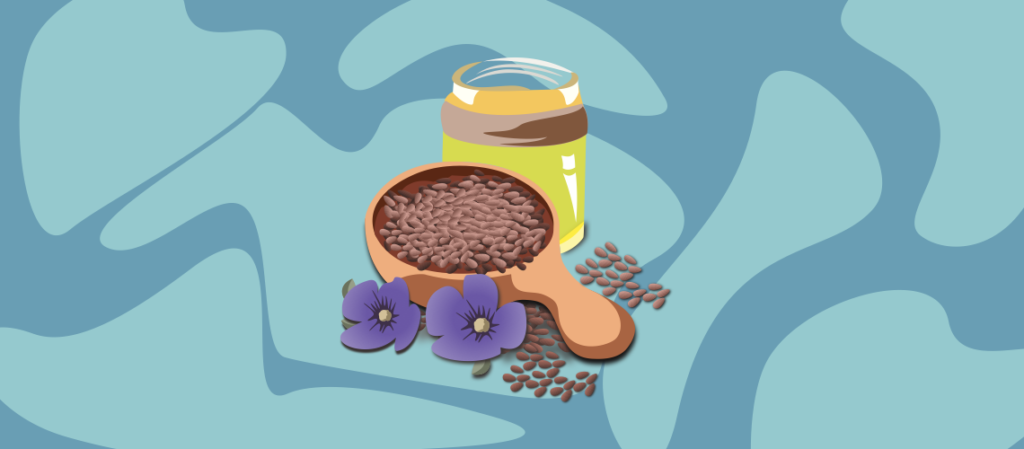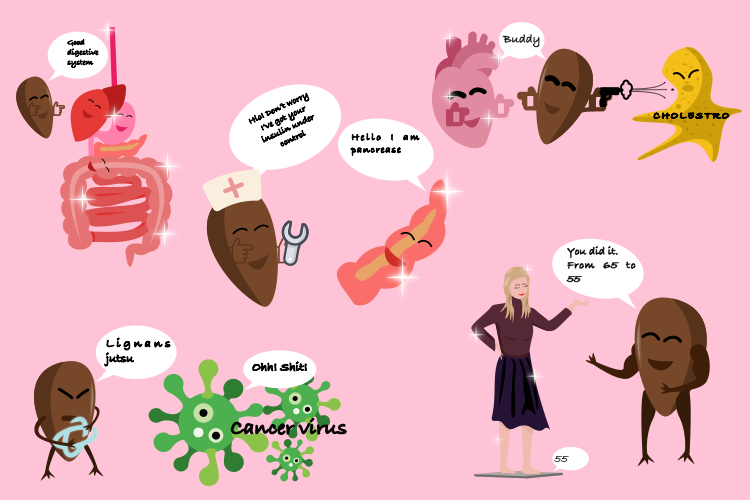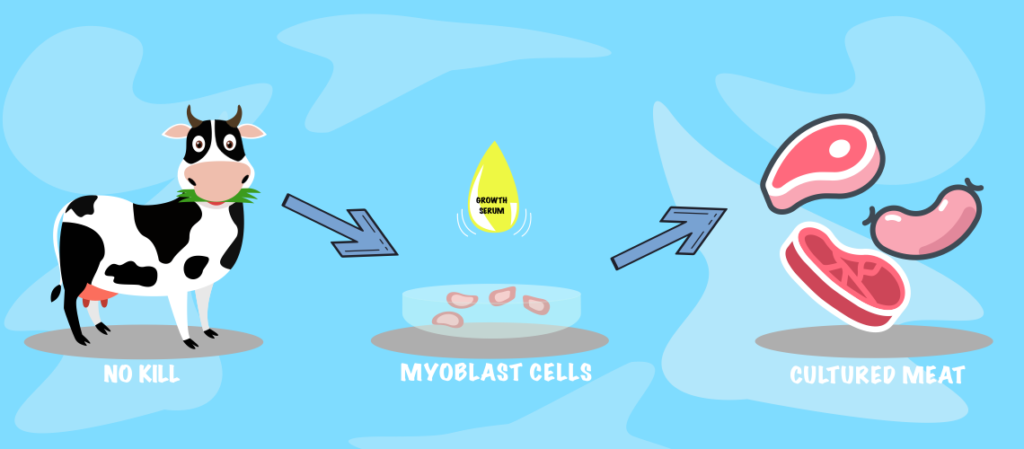
Warning! Serious questions ahead. Are you a foodie? Do you often feel hungry? What is the first thing that comes to your mind when your tummy doesn’t stop talking?
Let me make some guesses. Pizza? Burger and fries? Nachos?…Alright, anything in this whole world but healthy. Take it easy! It happens to everyone, including to a world class nutritionist.
However what should not happen is ignoring the aftermath. What should be taken seriously is facing the consequences after a good deal of cheat days.
Recently, I’ve been doing a good amount of research on “FLAX SEEDS”, the new generation flex to all the nutritionists, fitness freaks, public figures… and I can make a whole list of it. The question to deal with is whether or not YOU want to be on that list.
The research amazed me. So let me enlighten you a bit.
Flax seeds are one of the richest sources of essential omega-3 fatty acids, specifically, ALPHA-LINOLENIC ACID.
Dr Michael Gregor, MD, FACLM, stated flax seeds to be remarkably miraculous.
His journal titled- “Flaxseed: A Miraculous Defense Against Some Critical Maladies” is a ‘leave-everything-and-check-this-out’ kind of must-read.
Now, to those who still don’t feel convinced, do you mind if I go back to square 1? Or maybe 0? Trust me! Things are going to become pretty interesting.
THE ORIGIN
To begin with the history, where did it come from?
Flax seeds come from the flax plant, Linum usitatissimum. It likely was first grown in Egypt and was later cultivated worldwide. Lucky we!
The fibres were 2-3 times as strong as cotton. Thus, in the mid 20th century, North Americans used them as clothing. Long story short, cotton took over and now they grow flax to produce seeds.
HOW TO CONSUME?
The nutty flavoured (one of my favourite flavours) seeds can be self-served. Take a spoonful or aim it straight into your mouth, one by one, of course.
It’s fun!
The seeds can also be crushed or cold-pressed to release the flaxseed oil generally used in cereals and bread.
In the last decade, people have however become aware of the miracle seeds and with their skills have shifted to taking supplements and naturally getting their fill as a topping on various other healthy dishes. Cool, isn’t it?
Oh! And if you have your dog wagging its tail while on your lap or your cat meowing somewhere around the corner, they can have them too.

THE NUTRITION CHART
The regular serving size of ground flaxseeds is 2 tablespoons (tbsp).
That includes-
- 80 calories
- 3 gram protein ( 6% DV )
- 4 gram carbohydrates ( 1.33% DV )
- 6 gram fats ( 9.23% DV )
{ Omega-3 fatty acid, alpha-linolenic acid present}
- 4 gram fibre ( 16% DV )
- 60 mg magnesium ( 14.28% DV )
- 100 mg phosphorus ( 8% DV )
- 120 mg potassium ( 2.55% DV )
( DV = Daily Value )
HEALTH BENEFITS

Flaxseeds and flaxseed oil are chock full of protein, and as per the US Department of Agriculture’s “MyPlate” guidelines (do go through them), have several benefits:
- DIGESTION – Digestive issues like constipation can be resolved. Thanks to its high fibre content.
- LOWERING CHOLESTEROL – They lower low-density lipoprotein (LDP) or ‘bad cholesterol, preventing heart diseases and stroke.
- MANAGING CANCERS – Possible anti-cancer compounds present called ‘lignans’, which are polyphenols, lower the risk of breast and prostate cancers.
- WEIGHT MANAGEMENT – Flaxseed fibre makes you feel full. So the ones who are craving for some outward transformation, look out!
- IMPROVING INSULIN SENSITIVITY – Flaxseed oil helps fight type 2 diabetes, which involves the inability to use insulin to ferry glucose to cells (insulin resistance).
** As for now, flaxseeds being able to reduce hot flashes and other menopause symptoms are considered hyped due to lack of research.
SELECTION AND STORAGE
Whole flaxseeds are available at the stores. But people generally prefer ground or chopped ones as they are easier to digest and hence more effective. They ensure better absorption of nutrients in the body tissues.
You can either get flax meal or flour, or you can take the whole seeds and grind them at home. The second option is better as ground seeds coming from industries are actually processed, which means they have already lost some of their nutritional value during the process.
Flaxseed can be sensitive to heat and sunlight. Hence they are supposed to be stored in cool, dark places. The seeds are generally stored in a refrigerator in airtight containers to keep them fresh for months.
COOK AND BAKE
Alrighty! Are you ready to make flax seeds the powerhouse of your diet?
1- 4 tbsp (recommended daily)
- Use it in baking, like in chocolate bundt cake, warm blueberry scones or healthified strawberry cheesecake.
- Add it to your morning oatmeal.
- Dress your salad up with this.
- Have it with mayo.
- Spoon into your yoghurt or smoothie.
- Make it your breakfast foundation.

Flaxseed oil cannot be used as a cooking oil unlike olive oil or avocado oil because of its low smoke point. It’s better to use it directly with salads or as a dip. Simple and easy.
SIDE EFFECTS AND HEALTH RISKS
Even though they have few negative side effects, there are certain things you should be aware of:
- Raw flax seeds are toxic. You better roast or bake them.
- There is a limit to be maintained while you consume flax seeds: not more than 5 tbsp a day.
- Flaxseed inside your body behaves well as long as you drink plenty of water. Otherwise, it may make constipation worse. There are also chances of gastrointestinal issues like diarrhoea.
- Limit flaxseed and flaxseed oil consumption during pregnancy.
- Keep it out of your diet for at least a couple of weeks if you have a surgery marked on your calendar. Flaxseed oil may decrease your blood’s ability to clot.
- It is highly recommended not to take flaxseeds with blood pressure medication. Diabetic patients need to be extra cautious and they better discuss this with their doctor.
With proper instructions followed and precautions taken, flaxseeds can be indeed miraculous to every living being.
With increasing worldly issues and changing lifestyles, we need to become more cautious about ourselves, about each other. Proper nutrition and healthy eating with a little leniency can take us a long way to thriving and not just surviving.
So long…
Author: Aparajitaa Sinha
Editor: Gurpreet Kaur Bamrah
Visual Content: Anubhav Maharana

Aparajitaa Sinha
Author
Aparajitaa is a budding nutritionist and blogger.
Along with that dance, music and performing arts occupy a major portion in her heart.
She is extremely serious about health and fitness and is always contemporary in what she thinks and does.


